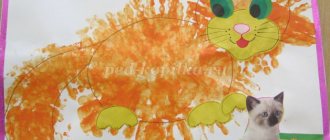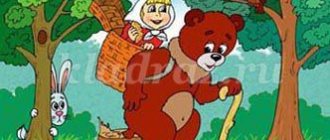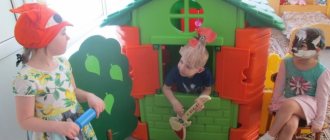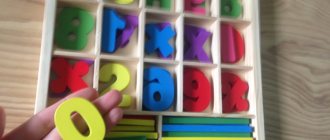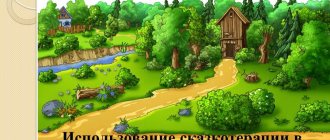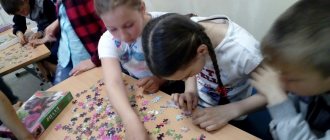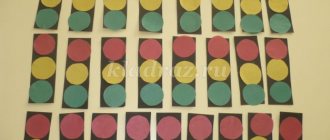Card index of games for the development of logical thinking in the middle group
Lyudmila Bessonova
Card index of games for the development of logical thinking in the middle group
"Clean up the kitchen"
Goals:
*To consolidate the ability to distinguish the size of objects: large, smaller, smallest.
* Practice the ability to arrange objects from left to right in ascending and descending order.
Equipment: cards with images of dishes of different sizes: large, smaller and the smallest.
Contents of the game: The teacher invites the children to look at the dishes that lie in front of them on the table, specifies the names, color and size.
He suggests putting things in order in the kitchen by arranging the dishes in descending and ascending order from left to right.
"Make a pattern"
Goal: development of the ability to determine the position of objects relative to other objects, perform a task according to the instructions of the teacher, and attention.
Material: geometric shapes, sheet of paper.
Contents of the game: the teacher suggests making a pattern of geometric shapes. Children work according to the instructions:
1. Take a circle and place it in the middle of the sheet.
2. Place a triangle above the circle.
3. To the right of the triangle, place a square.
4. Place a rectangle to the left of the circle.
5. Place an oval under the rectangle, etc.
“Call it in one word”
Goal: Development of the ability to name geometric figures of the same type with a general word.
Material: Geometric shapes of the same type (large and small squares; multi-colored triangles, etc.)
.
Contents of the game: 4 cards depicting geometric figures of the same type are laid out in front of the child. The child must name the figures in one word.
“Choose by size”
Goal: Development of the ability to classify geometric shapes according to one criterion (size)
.
Material: Geometric shapes (squares, rectangles, circles, etc.)
two sizes - large and small.
Contents of the game: The teacher places two circles on the table. Children place large figures near the large circle. Around the small circle there are small ones. The game is played with a small group of children (6-7 people)
.
"Find the extra figure"
Goal: Developing the ability to compare geometric figures with each other, to identify a figure that is different from others.
Material: Square, triangle, rectangle, circle, numbers: «2»
,
«3»
,
«4»
,
«5»
,
«6»
.
Contents of the game: The child is given the task of finding an extra figure. (Circle, it has no corners)
.
Now find the extra one among (Triangle, the other figures have four corners)
.
What are the names of the remaining figures? (Quadrangles)
.
From the numbers “2”
,
“3”
,
“4”
,
“5”
,
“6”
, choose those that fit this
group of figures . (Three quadrilaterals, four - each figure has four corners)
.
"What changed?"
Goal: Development of attention , observation, memory, self-control.
Material: Four large squares (three red, one green, two small green squares, one small green circle.
Contents of the game: The teacher invites the children - you close your eyes, I will remove one square, and you tell me which square I removed: large or small, red or green. When the children quickly complete the task, you can remove 2-3 squares at a time. The task is aimed at developing attention , observation, memory, self-control, and also prepares children to understand the operation of subtraction.
"Lotto"
Goal: mastering the ability to identify various forms.
Material: cards with images of geometric shapes.
Contents of the game: Children are given cards on which 3 geometric shapes of different colors and shapes are depicted in a row. The cards differ in the arrangement of geometric shapes and their color combinations. Children are presented with the corresponding geometric shapes one by one. The child, on card there is a presented figure, takes it and puts it on his card so that the figure coincides with the drawn one. Children say in what order the figures are located.
"Pick a figure"
Goal: to consolidate children’s ideas about geometric shapes and practice naming them.
Material. Demonstration: circle, square, triangle, oval, rectangle, cut out of cardboard . Handout: cards with outlines of 5 geometric lottos.
cards on your tables with figures of different shapes drawn on them, and the same figures on trays. Place all the figures on the cards so that they are hidden." Asks the children to trace each figure lying on the tray, and then overlays ( "hide"
) it onto the drawn figure.
"Long - short"
Goal: to develop in children a clear differentiated perception of new qualities of size.
Material. Satin and nylon ribbons of different colors and sizes, cardboard strips , story toys: a fat bear and a thin doll.
Contents of the game: Before starting the game, V. lays out sets of gaming didactic material (multi-colored ribbons, stripes)
.
The teacher takes out two toys - a teddy bear and a Katya doll. He tells the children that Misha and Katya want to be dressed up today, and for this they need belts. He calls two children and gives them ribbons rolled into a tube: one short - a belt for Katya, the other long - a belt for the bear. Children, with the help of V., try on and tie belts for toys. The toys express joy and bow. But then the toys want to change belts. The teacher suggests taking off the belts and changing their toys. Suddenly he discovers that the doll’s belt doesn’t fit on the bear, and the belt is too big for the doll. The teacher offers to examine the belts and spreads them side by side on the table, and then places a short ribbon on a long one. He explains which ribbon is long and which is short, i.e. he gives the name for the quality of quantity - length. After this, V. shows the children two cardboard strips - a long one and a short one.
Shows children how to compare strips with ribbons by overlapping them and tell which one is short and which one is long. "Wide - narrow"
Goal: to form a “broad - narrow”
.
The lesson is carried out in a similar way , but now children learn to distinguish the width of objects, i.e. wide and narrow ribbons of the same length. When creating a game situation, you can use the following game technique. Two cardboard strips are laid out on the table - wide and narrow (of the same length)
.
along a wide strip (path)
, but only one of them can walk along a narrow strip. Or you can play the story with two cars.
"Three squares"
Goal: to teach children to correlate three objects by size and indicate their relationship with the words: “big”
, small”,
“
medium ” , largest”,
“smallest”
.
Material. Three squares of different sizes, flannelgraph; Children have 3 squares, flannel.
Teacher: Children, I have 3 squares, like these (shows)
.
This one is the biggest, this one is smaller, and this one is the smallest (each of them shows)
.
And now you show the largest squares (children pick up and show, put them down. Now raise the middle ones . Now - the smallest ones. Next, V. invites the children to build towers from the squares. Shows how this is done: places on the flannelgraph from the bottom up, first the large one, then the middle one , then a small square. “Make such a tower on your flannelgraphs,”
says the teacher
"Hoop Game"
Goal: distinguishing and finding geometric shapes.
Game content: 4-5 story toys are used for the game (doll, nesting dolls, basket, etc.)
;
differing in size, color, shape. The toy is placed in a hoop. Children identify the characteristics characteristic of the toy, put into the hoop those geometric shapes that have a similar characteristic (all red, all big, all round, etc.)
Outside the hoop are figures that do not have the selected characteristic
(not round, not big, etc.) d.)
“Let’s collect beads”
Goal: to develop the ability to group geometric shapes according to two properties (color and shape, size and color, shape and size, to see the simplest patterns in the alternation of shapes.
Equipment. There is a long ribbon on the floor, on which figures are laid out from left to right in a certain alternation: red triangle, green circle, red triangle, etc.
Contents of the game: Children stand in a circle, in front of them are boxes with multi-colored geometric shapes. The teacher offers to make beads for the New Year tree. He points to a ribbon with laid out geometric shapes and says: “Look, the Snow Maiden has already started making them. What shapes did she decide to make the beads from? Guess which bead is next.” Children take two of the same figures, name them and begin to make beads. They explain why they lay out this particular figure. Under the guidance of the teacher, mistakes are corrected. Then V. says that the beads have scattered and need to be collected again. He lays out the beginning of the beads on the tape, and invites the children to continue. He asks which figure should be next and why. Children choose geometric shapes and arrange them in accordance with a given pattern.
"Seek and find"
Goal: to learn to find objects of different shapes in a room by word name; develop attention and memory.
Equipment. Toys of different shapes.
Contents of the game: The teacher lays out toys of different shapes in different places in the group room in advance and says: “We will look for round-shaped objects. Find everything that is round in our room and bring it to my table.” The children disperse, the teacher provides assistance to those who are having difficulty. Children bring objects, place them on the teacher’s table, and sit down. The teacher examines the objects brought with them and evaluates the result of completing the task. The game is repeated, children look for objects of a different shape.
"Learn and Remember"
Goal: to teach children to remember what they perceive, to make choices based on presentation.
Equipment. Cards depicting three single-color geometric shapes (circle, square, triangle; circle, oval, square, etc., a set of small cards depicting one shape to be placed on large cards .
Contents of the game: In front of the child there is a card with a picture of 3 shapes. The teacher asks to look at it and remember what shapes are drawn there. Then he gives the children sheets of paper and asks them to cover their cards . After this, he shows a small card , places it face down on the table, mentally counts to 15, asks the children to take off the paper and show on their cards the same shape that he showed. To check, the teacher again shows the sample card . As children master the game, they are given two cards (6 forms), then three (9 forms)
.
"Beautiful pattern"
Goal: to learn to select quantities based on the word-name of objects, to develop attention ; to form a positive attitude towards the result obtained - the rhythmic alternation of values.
Equipment. Strips of clean thick paper according to the number of children, geometric shapes of different sizes for laying out patterns (circles, squares, rhombuses, hexagons, etc.)
; trays, typesetting cloth.
The teacher hands out sheets of paper to the children and places trays with geometric shapes on the table. He says that now they will lay out a beautiful pattern, shows a sample of the action: “Big square. (Takes the form and inserts it into the typesetting canvas)
.
A small square, another small square." (Inserts it back into the canvas, etc.)
then the teacher suggests laying out the forms under dictation. At the beginning, he makes sure not only that the values are correctly alternating, but also that the children act from left to right and maintain the same distance between elements. When the task is repeated, other forms are given, and their alternation also changes. In conclusion, the teacher examines the resulting patterns and gives all works a positive assessment.
«Painting»
Goal: to learn to place objects on a sheet of paper (top, bottom, sides)
;
develop attention , imitation;
consolidate the perception of holistic objects and distinguish them from each other. Equipment. A large sheet of paper for the panel, large applique details (sun, strip of land, house, figurine of a boy or girl, tree, bird, sheets of paper, the same small applique elements, trays, glue, tassels, oilcloths, rags according to the number of children.
Contents of the game: The teacher tells the children that they will make a beautiful picture : he will do it on a large sheet of paper attached to the board, and they will do small ones on their own sheets of paper. You just need to watch carefully and do everything as the teacher does. Then the teacher distributes material for the application to the children. First, he sticks a strip of earth at the bottom, the sun at the top, etc. The teacher does everything slowly, recording his actions at each moment and giving the children the opportunity to choose each element and place it correctly on paper. If necessary, helps the child determine the place on a sheet of paper (top, bottom)
. Upon completion, the teacher compares the children’s work with his own, discussing the spatial arrangement of objects, praises them, evoking a positive attitude towards the result of the work. Then he briefly describes the content of the resulting image, fixing the spatial arrangement of objects: “The boy went out into the street. I looked - the earth was below, the sky was above. The sun is in the sky. Below, on the ground, is a house and a tree. The boy is standing near the house on one side, and the tree is on the other side. A bird is sitting on a tree."
"Geometric figures"
Goal: develop children's logical thinking , familiarize children with basic geometric shapes.
Material: cards with images of a house, Christmas tree, sun, etc. made of geometric shapes.
Progress of the game. After talking about the pictures , ask the child to show a square (triangle, circle, rectangle, then circle the figures depicted with dotted lines with a pencil, and then color the picture . As you work, repeat the words with the child more often: “The ball is round, the window is square.”
“Find and name the figure”
Goal: to develop children's logical thinking , to train children in their knowledge of geometric shapes.
Material: cards with images of geometric shapes.
Progress of the game. Invite your child to first color the figure in the frame, and then the same one, highlighting it from the other two. Ask him to name the shapes he knows and the color he chose to paint.
"Flags and garlands"
Purpose of the game: develop children's logical thinking , exercise knowledge of colors and geometric shapes.
Material: cards depicting a garland of flags and other geometric shapes.
Progress of the game. Invite the children to color in each first shape of the garlands and flags, then use a pencil to trace the shapes shown in the dotted line and color them in any color. Then ask the child to show and name the shapes, and also say what color he painted them.
"Chicken Family"
Purpose of the game: to train children in recognizing and naming geometric shapes, to develop children’s logical thinking .
Material: plot picture depicting a chicken family, card depicting geometric shapes.
Progress of the game: Look at the story picture (pre-colored)
.
“Who is drawn? Who is dad and mom in the family? Where are the kids? How many chickens? What color are they?" Then offer a card with geometric shapes depicted and ask them to find in it those shapes that need to be cut out and glued to the image of a hen, rooster, chickens.
Help your child cut it out and let him paste it himself. When you're done, rejoice at his success. You can invite the child to show the largest circle , a smaller circle and the smallest circles in the picture.
At the end of the game, check which geometric figure you performed. Offer to find round objects in the surrounding space. Let the child draw circles with his finger on the table, on the floor, or in the air. You can suggest drawing circles on paper.
"Sail"
Purpose of the game: to introduce children to the triangle shape and develop thinking .
Material: plot picture depicting boats made of geometric shapes, card with geometric shapes.
Progress of the game. Invite the children to talk about what is drawn in the picture , then trace the sails with a pencil. Ask what geometric figure they resemble and what other geometric figures they know.
After this, the children look for a small triangle, then a large one. Help them, if they find it difficult, to color, cut out and paste the shapes onto the image.
At the end of the game, check which geometric figure you cut out. Offer to find triangular-shaped objects in the surrounding space. Let the child draw triangles with his finger on the table, on the floor, or in the air. You can suggest drawing a triangle on paper.
"Uploading pictures "
Purpose of the game: development of children's logical thinking , consolidation of knowledge of geometric shapes.
Materials: sample cards with drawings of geometric shapes, blank cards , cut out geometric shapes of different colors and sizes.
Progress of the game. Look at the drawings with your children. Offer to find familiar geometric shapes on them.
Cut out shapes from colored paper in two copies and make appliqués from one with the children. Offer the second set of figures to the children for laying out images. Don’t forget to memorize the names of the colors in your children’s memory while playing. For the second image, cut out the shapes so that their shape is the same but their color is different, so that the child can find the part by both shape and color.
"Design according to the scheme"
Purpose of the game: development of logical thinking in children of primary preschool age.
Material: cards with contour diagrams, builder's details.
Progress of the game. Children are given a card with contour diagrams and asked to lay out these images from large parts of a building set on the table, using this card as a sample . To make things more challenging for children, offer a few more parts than they need.
“Building from sticks”
Goal: consolidation of knowledge of geometric shapes, development of logical thinking of children .
Material: cards with outline images of objects, sticks of different lengths.
Purpose of the game. Offer the children sticks of different lengths, ask them to select the longest, shortest and shortest. At the child’s suggestion, make a figure out of sticks. Then give the child a card , look at the outlines of objects with him, let him recognize them and name them. Then offer to lay out any figure. As you work, fix the names of familiar geometric shapes that will appear during the laying out process. Ask them to lay out figures of their own design with chopsticks.
"Find the figure"
Purpose of the game: to familiarize children with the names of geometric shapes, to introduce cones, cylinders and prisms.
Material: building designer set, cards with images of geometric shapes.
Progress of the game. Ask your child to find and bring a cube, a brick, then a long plate (use regular building material for construction)
.
Show your child a cone and ask him to find the same part (then a cylinder, then a prism)
.
After this, give the child a card and ask him to find these details.
"Find a Pair"
Purpose of the game: development of logical thinking , practice naming colors and naming geometric shapes.
Material: cards with images of geometric shapes divided into 8 parts, uncut cards according to the number of players
Invite your child to play a game. (One of the cards is cut into eight pieces.)
Place the cut
cards on a whole card on a card ( shapes identical in shape, but different in color and size)
.
Pick up this or that card and ask to find the same part, but of a different color or size.
When completing the task, practice naming colors for children. “Build according to the scheme”
Purpose of the game: to teach children to carry out elementary constructions, focusing on the diagrams.
Material: building diagrams, construction kit.
Progress of the game. Talk to your children about the building parts they know and show them their properties. Show the card , ask what is shown on it, offer to look at it, and say what parts the building is made of. Ask them to build the same buildings from building parts. It is important that the details are shown in actual size.
“Putting on the details”
Purpose of the game: to teach children to lay out images using the overlay method.
Material: cards with outline drawings, construction kit or flat geometric shapes.
Progress of the game. Children are taught to lay out images by superimposing three-dimensional details of one of the faces on the drawing. Offer the children a map and ask them to create beautiful pictures (show with an example of installing one part)
.
"Laying out figures"
Purpose of the game: to train children in laying out images from geometric shapes using diagrams.
Material: image maps , construction set.
Progress of the game. Children are offered diagrams and geometric shapes for laying out images. After completing the task, they are asked: “What shapes did you use to make this car?” How many figures did you need for this rocket? How many identical figures are there?”
"Find the odd one out"
Purpose of the game: to develop logical thinking in preschoolers .
Material: cards with images of geometric shapes.
Progress of the game. The map shows rows of geometric shapes. Children are asked to look at them and determine what is unnecessary on them, then justify why.
“What does it look like?”
Purpose of the game: to develop visual and imaginative thinking .
Material: a set of planar geometric shapes.
Progress of the game. The teacher one by one shows the cut out geometric shapes, names them and asks them to say what they look like. For example: a ball - a bun, a sun, a face, a balloon, etc.
“Building from sticks”
Purpose of the game: development of logical thinking in children .
Material: sticks of different lengths in three sizes, cards depicting simple pictures .
Progress of the game. Children are given sticks of different lengths and asked to divide them into three parts according to size. Then they give pictures (real images of simple-shaped objects: a flag, a car, a boat with a sail, a wheelbarrow, a flower, a vase, etc.) and ask them to lay out the image of these objects with chopsticks.
"Match"
Purpose of the game: development of logical thinking in preschoolers .
Material: drawings depicting geometric shapes and real objects that are well known to preschoolers.
Progress of the game. Children are offered two drawings, one depicting geometric bodies (a cube, cylinder, ball, cone, etc., on the other, real objects that are well known to preschoolers, they are asked to name what geometric body this or that object resembles. Invite the children to play the game " What does it look like?" - find objects in the surrounding space that resemble geometric bodies familiar to them. Ask the children to show and name round, square, shapes in one and the other drawing.
"Remember what it's like"
Purpose of the game: to train children in naming geometric shapes.
Material: cards with images of geometric shapes.
Progress of the game. Children are offered cards with pictures of construction parts. The teacher asks to name the detail and remember objects that are similar to it, while justifying why he points out these objects.
"Arrange your room"
Purpose of the game: development of logical thinking in preschoolers .
Material: sheet of paper (35*45cm, construction set, plane geometric shapes
Progress of the game. The teacher offers the children a sheet of paper (35*45 cm)
and says that this is the floor of the doll’s room, asks to build it with bricks (the walls of the room, leaving gaps for the window and door. After the children do this, he takes out the sheet and places it next to the built room. Then he takes out geometric shapes and offers to lay them out on paper, selecting pieces of furniture that are similar in shape
(a square is a stool, a rectangle is a bed, etc.)
. The teacher examines the resulting diagram with the preschoolers and asks them to arrange the “furniture" according to it in a room lined with bricks. At the end of the work, the children compare the image with construction.
“Putting on the details”
Purpose of the game: development of logical thinking in preschoolers .
Material: diagram cards , construction parts.
Progress of the game. Preschoolers are given two cards : on one, in the form of a diagram, various towers are depicted, on the other, building parts that should be selected to solve this problem. Target
task: place the parts in the outline so that they come into contact with the surface of the sheet on one of the faces. In the process of solving a task, the teacher clarifies what parts the child uses, what color, what shape of edges this or that part has, how many edges the part has, how many parts went into assembling the image.

